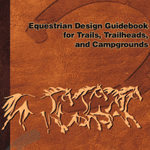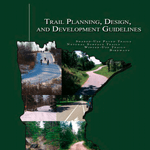BLM Sign Guidebook
Trail Competencies
-
Summary
The purpose of this Guidebook is to establish standards and guidelines for planning, developing, and managing signs for the BLM-administered public lands and waters.
Overview
The Bureau of Land Management (BLM) uses the highest standards for signing the public lands and waters under its jurisdiction and management. Signs are intended to guide, inform, and protect visitors. This National Sign Guidebook (Guidebook) establishes uniform guidelines and directs the reader/user through the sign planning process.
A. Purpose of This Guidebook
The purpose of this Guidebook is to establish standards and guidelines for planning, developing, and managing signs for the BLM-administered public lands and waters.
This Guidebook:
1. Describes the National Sign Program planning process.2. Describes the different types of signs and the locations where they are used.
3. Outlines the national design standards.
4. Provides specific design standards that apply to certain types of signs, including material and specification requirements.
5. Identifies procurement procedures.
6. Delineates the inventory and maintenance guidance. 7. Provides reference material and other resources.B. Signing Guidebook Principles
The following principles were used in formulating the National Sign Guidebook and should be used in administering the BLM National Sign Program:
1. Signs must deliver understandable messages to visitors. Each sign should address a single topic and not include jargon or technical terms. Messages should not be mixed.
2. The established BLM logo must be used, where appropriate.
3. Signs must comply with the Uniform Federal Accessibility Standards (UFAS) and the Americans with Disabilities Act Accessibility Guidelines (ADAAG). Sections 4.1 and 4.30 from both standards provide specific guidance for signs (see Appendix 1). Persons with disabilities must be consulted when designing informational signs and interpretive materials.
4. Signing situations related to vehicular and pedestrian traffic should follow the specifications established in the Manual on Uniform Traffic Control Devices (MUTCD), published by the Federal Highway Administration.
5. BLM-approved international symbols and established signing industry standards must be used for sign design, fabrication, installation, and maintenance.
6. Signs must comply with pertinent Federal, State, and local laws, as appropriate.
7. The standards and guidelines in this National Sign Guidebook must be applied consistently to ensure that areas are safe and to enhance visitors’ experiences on the BLM’s public lands and waters.
8. Whenever possible, signs should be used in conjunction with other media, such as maps, brochures, interpretive materials, etc.
C. Funding
All funding needs for conducting inventories and reviews and preparing maintenance schedules, as well as for the cost of planning, designing, fabricating, installing, and main taining signs, are the responsibility of the Field Office or designated area. The National Sign Coordinator can assist with cost estimates for design, fabrication, and installation.
D. Sign Review
A periodic review should be performed by the appropriate Area or Field Office, along with any managing partners, to address adequacy, wording, and design standards. This review should also include, but not be limited to, location concerns, the relevancy of the signs, condition of signs, visual clutter, the relationship to other signs in the area, and program issues.
E. Sign Maintenance
Each office should prepare a maintenance schedule for signs currently in place. This schedule should then be reviewed and updated annually to address damage, visibility, legibility, and appearance. A five-year plan should be developed, based on the annual maintenance plan, for each office.
F. Sign Plan Approval
An approved sign plan must be in place prior to the fabrication and installation of new signs. The sign plan must be approved by the Area/Field Manager.
G. Procurement Process
The National Sign Center, located in Rawlins, Wyoming, is the source for all signs.
H. Data Bases
Until a sign module to the facilities maintenance system is developed, BLM
Trail Types Covered
General. All trail types are relevant.
| Publisher | Bureau of Land Management | |
|---|---|---|
| Published | Dec 2004 | |
| File Format | ||
| File Size | 5.99 MB | |
783 people have viewed this resource




